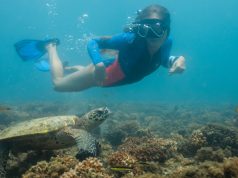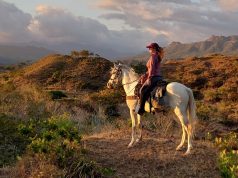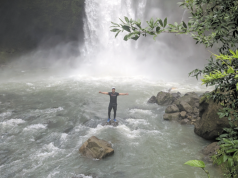Waterfalls, protected forest parks and beautiful coasts on both oceans
Veraguas is the only province in the country that connects with two oceans: the Atlantic and the Pacific. Due to its mountainous origin with cloud forests that produce river trails that give rise to the origin of its name, which seems to come from the expression “Ver Aguas”, which means: Watch the waters.
Its prolonged rains created magical tropical places with high-falling waterfalls, lakes, rivers and the sea near mountains, which lend themselves to adventure and extreme sports. This province has more than 410 kilometers of coasts, beaches and islands, including the largest in the country: Coiba Island, with 80% virgin nature.
The activities that tourists most seek to enjoy in this destination are closely related to the sea, such as sport fishing, diving, visiting exotic solitary islands but with a rich biodiversity.
Santa Fe
Founded by Captain Francisco Vasquez in 1557, it is located on the Veraguas highlands, surrounded by jungle with protected areas such as the Santa Fe National Park to the north and the Ngäbe Region to the west.
In its territory is the third longest river in Panama, the Santa Maria River, highly visited by tourists to swim in its crystal clear waters. They also have fruitful land for agriculture and their hills are favorable for planting coffee plantations.
Among its greatest natural attractions is the Santa Fe National Park with more than 700 square kilometers of primary forest and fifty waterfalls. To get to know all you must take trails, among them the most recommended are: Alto de Piedra Trail (1 km long) and the path that leads to the Bermejo waterfall, a journey of approximately 2.5 km and which takes almost two hours to cover. back and forth.
Waterfall Circuit
The Veraguas Province is one of the favorite destinations for hiking to search for waterfalls, jets and rivers. There are a large number of waterfalls, among them are those found in the San Jose community in the San Francisco sector. In this town there is a popular network of waterfalls, where you can visit three of them because are very close to each other; there is even an optional fourth waterfall to discover if you have time.
To carry out this circuit, you must arrive at the community of San Jose, to travel a journey by 4 x 4 car since the road is very rocky. Around 45 minutes should pass to proceed to take a trail and walk for 10 minutes, until you reach the lower part of the Chorrillito Waterfall. This fall turns out to be impressive because it is 90 to 100 meters high, with a natural pool ready for swimming and splashing around.
The Gulf of Montijo
In the southern part of Veraguas, within the Montijo district, Sona, Rio de Jesus, Mariato and Santiago, is the Gulf of Montijo. A paradise where approximately 13.7% of the country’s mangroves are found and represents 8% of the mangroves in the Central American Pacific, due to its 80,765 hectares.
In the Gulf of Montijo the mangrove forest predominates with different types of them such as the red mangrove, the black mangrove and the white mangrove. Reason why scientific tourism is also interested in visiting these parts, where you can see migratory birds that come to nest or pass through this habitat. Among the most observed birds are: the mangrove hawk, the northern kingfisher, the eagles of prey, among others.
Other species such as red spider monkeys, otters, needle caimans also live there; more than 170 varieties of fish, crustaceans such as shrimp, black shell, lobsters, prawns and crabs.
To get to Golfo de Montijo you must take the Pan-American Highway. When you arrive to Santiago City, in front of the Piramidal Hotel, you have to make a turn off to take the Central Avenue, in direction to the Santiago Apostol Cathedral Church. Take the second street on the left (behind the church) where you will arrive at La Colorada and you will find a second intersection to the right that will lead you to Montijo.

Mata Oscura Beach
Located south of the district of Mariato in Veraguas, there is a paradise in the Panamanian Pacific suitable for the spawning of four of the seven species of sea turtles, and this is Playa Mata Oscura. Its inhabitants continue to work in community and rural tourism, where sea turtles are its main protagonists.
One of its annual events with the greatest tourist and scientific attraction is the Sea Turtle Fair in October, where in addition to seeing specimens of sea turtles reach the shore of the beach to lay their eggs, hatchling release activities are also carried out among others.
In this fair there is also handicrafts sale alluding to the flora and fauna of the surroundings, awareness talks about the importance of marine life and its conservation, to name a few. It is also part of the Turtle Route initiative, where groups organized tours for observation of turtles at night, locals are trained to protect these species and their environment, support is provided for agro-tourism proposals in the surroundings, among others.
Another of the great attractions is being able to see a very particular specimen such as the canal turtle (Dermochelys coriacea), the largest marine turtle in the world and an almost extinct species.
The Agua y Tierra Foundation (Fundat) is a movement in charge of safeguarding these species of sea turtles. It is also a reference if you want to find more information on its page www.fundat.net about community and rural tourism activities in Playa Mata Oscura.
Calovebora in the Atlantic
The population of Veraguas is betting more and more on beach tourism in the Calovebora sector in the Atlantic, due to the recently inaugurated 35-kilometer highway that reaches this town.
The community of Calovebora works on sustainable tourism, mainly through tours to Isla Escudo de Veraguas, diving, kayaking, fishing, surfing and its lodging service.

How to get there?
To get to the Atlantic side of Veraguas, you must travel along the Pan-American Highway and take a detour through the city of Santiago towards Santa Fe and travel to Guabal, where the asphalt route used to arrive. The road begins right in front of El Guabal Basic Educational Center and ends in front of the Calovebora School, a place from where you can watch the Atlantic Ocean.
Things to Do
Go and take the Eco Ruta Tortugas experience at Playa de Mata Oscura, located in the Mariato District in Veraguas. Its locals are committed to community and rural tourism. They have a Fair alluding to the Sea Turtle (October), release of hatchlings, mangrove tours among others. Contact Jacinto Rodriguez, a specialized guide, at tortujac@gmail.com or by calling (507) 6575 – 8956.
Take a day to enjoy sport fishing Off Shore between Cebaco island and Mariato. The coasts of the Pacific Ocean south of Veraguas have good weather conditions almost all year round, making it ideal for going after large marine specimens.Information: www.pacificadvent.com
Learn how to get to the Atlantic side by taking the Calovebora highway. The landscapes that you can enjoy from Guabal, through Rio Luis to Playa Calovebora, are unique. Start this route advancing along the Santa Fe highway.
Visit the Santa Fe National Park, with trails ranging from quick adventures to day trips. In this enclosure you can see large waterfalls such as the Bermejo. These impressive waterfalls are on the edge of the park and reach up to 35 meters in height. Information: Santa Fe Chamber of Tourism, on its website www.santafepanama.org
Relax learning more about coffee production in Santa Fe de Veraguas. You can visit coffee farms with a processing plant to learn about the process, from the selection of the best beans, to roasting and final finishing. Information: www.coffeemountaininn.com















